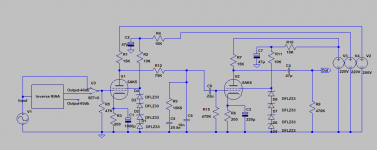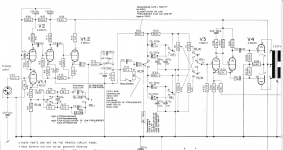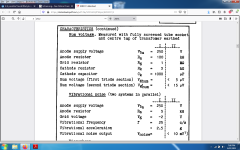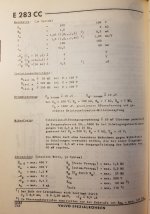What harm would there be in using 300VDC well filtered but unregulated?
Maybe hum problem. Regulator is just better filter than typical CLC-chain.
Last edited:
@ Philwait
I repeat, go with the 6GK5 in the 1st gain block. Why? 12AX7/ECC83 is high μ (100)/low gm (1.6 mA./V.). 6DJ8/ECC88 is medium μ (33)/high gm (12.25 mA./V.). High μ is needed to overcome the losses in the RIAA network. High gm is needed for superior S/N performance. The 6GK5 is both high μ (78) and high gm (15 mA./V.).
A buffered 'X7 section in the 2nd gain block role is more than sufficient.
A 6DJ8 family tube, with its sections in cascode, will provide adequate 1st block gain. However, PSRR in cascodes is wretched. Very well filtered and regulated B+ is essential, when working with cascodes fed a mV. level signal.
I repeat, go with the 6GK5 in the 1st gain block. Why? 12AX7/ECC83 is high μ (100)/low gm (1.6 mA./V.). 6DJ8/ECC88 is medium μ (33)/high gm (12.25 mA./V.). High μ is needed to overcome the losses in the RIAA network. High gm is needed for superior S/N performance. The 6GK5 is both high μ (78) and high gm (15 mA./V.).
A buffered 'X7 section in the 2nd gain block role is more than sufficient.
A 6DJ8 family tube, with its sections in cascode, will provide adequate 1st block gain. However, PSRR in cascodes is wretched. Very well filtered and regulated B+ is essential, when working with cascodes fed a mV. level signal.
1/f noise is determined by manufacturing processes, and is largely independent of valve type designations. There's a good reason why it's not specified in EIA datasheets; it's difficult to control for, because poorly understood. Still true today.
A general comment on phono equalizers: without specifying the cartridge driving the electronics, an optimum design is impossible, and discussion without that information is easily led astray. Half a Henry inductive sources are in no way a 600 Ohm resistive source, and noise and frequency response assumptions based on this error are largely wrong.
All good fortune,
Chris
A general comment on phono equalizers: without specifying the cartridge driving the electronics, an optimum design is impossible, and discussion without that information is easily led astray. Half a Henry inductive sources are in no way a 600 Ohm resistive source, and noise and frequency response assumptions based on this error are largely wrong.
All good fortune,
Chris
Merlinb measured many dozens of valves for his AES article and while there is a considerable spread between valves with the same type numbers, some types do generally behave better than others. The ECC83's generally have remarkably little 1/f noise.
I agree re the 6GK5.
The PC900 (or 4HA5) might be even better with µ=84 and 20 mA/V.
One of the latest developments of the tube era and still easily available.
I have seen many phono preamps using this tubes recently.
Best regards
Philipp
The PC900 (or 4HA5) might be even better with µ=84 and 20 mA/V.
One of the latest developments of the tube era and still easily available.
I have seen many phono preamps using this tubes recently.
Best regards
Philipp
@ Philwait
I repeat, go with the 6GK5 in the 1st gain block. Why? 12AX7/ECC83 is high μ (100)/low gm (1.6 mA./V.). 6DJ8/ECC88 is medium μ (33)/high gm (12.25 mA./V.). High μ is needed to overcome the losses in the RIAA network. High gm is needed for superior S/N performance. The 6GK5 is both high μ (78) and high gm (15 mA./V.).
A buffered 'X7 section in the 2nd gain block role is more than sufficient.
A 6DJ8 family tube, with its sections in cascode, will provide adequate 1st block gain. However, PSRR in cascodes is wretched. Very well filtered and regulated B+ is essential, when working with cascodes fed a mV. level signal.
Yamamoto CA03 phono (with 6AK5W tubes) is very musical one.
CA-03, CA-03L, and EQB-01 amplifier/Yamamoto sound craft
Attached the sample schematic.
CA-03, CA-03L, and EQB-01 amplifier/Yamamoto sound craft
Attached the sample schematic.
Attachments
Is an output impedance of 15k ohms low enough for a phono stage in this day and age?
I figure these days, a phono stage is likely to drive the volume control on a class D or similar power amp, which is usually 10k ohms, sometimes as low as 5k ohms. So a phono stage may have to drive a load as heavy as 5k ohms. Therefore, said phono stage should probably have an output impedance of no more than 500 ohms. A cathode follower or MOSFET source follower on the output will solve that problem.
I figure these days, a phono stage is likely to drive the volume control on a class D or similar power amp, which is usually 10k ohms, sometimes as low as 5k ohms. So a phono stage may have to drive a load as heavy as 5k ohms. Therefore, said phono stage should probably have an output impedance of no more than 500 ohms. A cathode follower or MOSFET source follower on the output will solve that problem.
As you can see in the link, it has line stage too, and output impedance of the line stage is 1k6.
The PC900 (or 4HA5) might be even better with µ=84 and 20 mA/V.
6f12p triode-pentode. Pentode has gm=19.5mA/V. Triode has same gm and mu=100.
That link gives funny specs:
Quite a S/N for a phono amplifier.
- residual noise: -- 2.3mV - signal to noise ratio: -- 110dB
Quite a S/N for a phono amplifier.
Until I see the test lab I don't believe on specification declared on internet.
Then, I always raccomend to start the building of a project only for the circuit where the test lab are shown.
This is the only way to get a certified results if the indication of the designer are done.
In addition the use of a low Z riaa network is an help about s/n followed froma good selection of tubes.
Normally who buy the tube online get the stuff tested on a normal tube tester so in one only point.
The best way is to selected them previously in a test circuit or tu buy more samples and test them directly on circuit comparing the two channel for the minimal prameters as gain ( < 0,5 dB of difference) , thd and noise ( included microphony)
Regarding PC900 I am partially agree, I am workin on it and it is interesting.
The EF184 in triode it is also interesting.
Walter
Then, I always raccomend to start the building of a project only for the circuit where the test lab are shown.
This is the only way to get a certified results if the indication of the designer are done.
In addition the use of a low Z riaa network is an help about s/n followed froma good selection of tubes.
Normally who buy the tube online get the stuff tested on a normal tube tester so in one only point.
The best way is to selected them previously in a test circuit or tu buy more samples and test them directly on circuit comparing the two channel for the minimal prameters as gain ( < 0,5 dB of difference) , thd and noise ( included microphony)
Regarding PC900 I am partially agree, I am workin on it and it is interesting.
The EF184 in triode it is also interesting.
Walter
You don't need more than 73...75db SNR with riaa systems unless you're listening into a dead silent echo-less chamber where you could hear your own heart.Better improve the other parameters.Vinyl SNR at 5 khz might be 90 db, but the signal is covering all other noises, including its own distortions and usually the ambient noise is around -40...-35db, that's 30 db over maximum vinyl surface noise...
In my opinion it is always better to reach the maximum s/n possible for the topology you are using, of course.
There is no reason to refuse this goal even if the real dynamic of LP , at the end, is not very high.
On one phono circuit, personal, I get 82-84 dB ( weighted A) dB with tubes, it is very quite.
And it is evident that other parameters will be, possible, at the best.
Walter
There is no reason to refuse this goal even if the real dynamic of LP , at the end, is not very high.
On one phono circuit, personal, I get 82-84 dB ( weighted A) dB with tubes, it is very quite.
And it is evident that other parameters will be, possible, at the best.
Walter
It is also very difficult to accept trading input saturation capabilities and soft clipping behavior for useless SNR...Every single method i found avoiding all the problems at once was expensive.This topic started with a NO-NO to d3a for actual price reasons, but using the best pentode for audio outhere isn't the best secret could be given away by people really knowing what low noise audio is about.I have d3a, i can use them any time, they are litterally 6 feet away from me, but for a few years i stopped trying random opinions and tried to find and understand the best equipment already designed and built by the best companies that were active in recording industry when the tubes were the only option . Better start with the best from the tube era if you really want to understand what tube use is and maybe ask yourself why you find almost nothing relevant on EMT jpa-66 schematic(basically i'm the only one ever to talk about it here, while i can bet there are on this forum guys having its real schematic, but never mentioned anything about it, and that is because people who know real valuable secrets never give them out for nothing.The best vintage audio equipment were all swiss made, and swiss people are known for protecting secrets for as long as possible...We barely accepted switching power source in audio in the last 10 years while Studer a820 had it in the 80's recording pretty much all european and a good hunch of american music you get today as vintage...
for pure fun:
EMT 139st phono schematic | nvduybom | Flickr
What's the purpose of the notch filter in the EMT139 st b ?- Vinyl Engine
EMT139について(1) - Decca Decolaがお嫁入り
Now tell me if you know what the picture below represents and of what importance might be for a phono preamp:
for pure fun:
EMT 139st phono schematic | nvduybom | Flickr
What's the purpose of the notch filter in the EMT139 st b ?- Vinyl Engine
EMT139について(1) - Decca Decolaがお嫁入り
Now tell me if you know what the picture below represents and of what importance might be for a phono preamp:
Attachments
Now tell me if you know what the picture below represents and of what importance might be for a phono preamp:

Is that the schematic of the phono section of EMT JPA66? It certainly looks like an EMT circuit. The input impedance is 1M for phono, not 47K?
- Home
- Amplifiers
- Tubes / Valves
- Is it possible? Good RIAA phono amp using new tubes?



